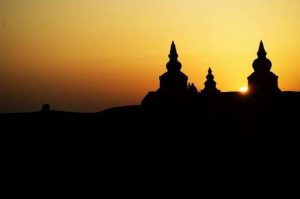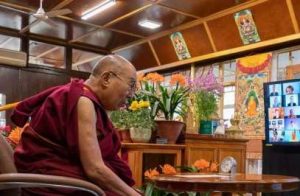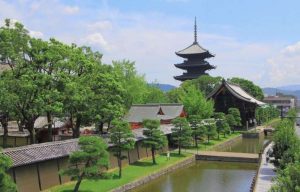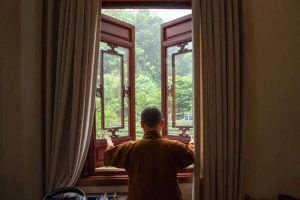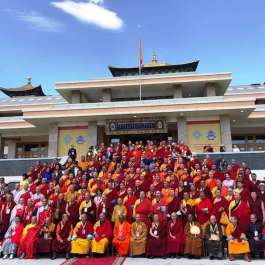
“The best thing you can do with your exposure to ancient Asian dances,“ advised my post-graduate supervisor Dr. Peter Brinson (1923–95) of the Laban Centre for Movement and Dance, Goldsmith’s College, University of London, “is to use it to expand the concept of knowledge in the West.” Those were his parting words to me. He died shortly after and I submitted my thesis for a Master of Philosophy in dance research without him. I’ve always heeded his advice to use my understanding of ancient Asian dances to expand our concept of knowledge, and have made a determined effort to explore what he meant by those words.
As director of the London office of the Calouste Gulbenkian Foundation, Dr. Brinson was responsible for the creation, development, and inclusion of dance programs and departments in UK higher education. His dedication resulted in the UK having some of the finest theoretical and research-based dance education in the West. The Laban Centre has integrated to become part of the prestigious Trinity Laban Conservatoire, still in Southeast London. Elsewhere in London, the dance offerings at the University of Roehampton are among the finest dance research programs in Western academics, including an extraordinary new degree, MA Choreomundus, International Master of Dance Knowledge, Practice and Heritage. This degree is taught at three collaborating universities in England, France, and Norway.
In effect, Dr. Brinson was suggesting that the concept of knowledge is bigger in Asia than in Western culture. He saw the inclusion of dance in higher academics as a sign of its legitimacy as a subject worthy of study. Many Asian cultures, including Buddhist and Himalayan societies, regard dance as knowledge; a tradition of dance as a repository of knowledge; a dancer as the steward of knowledge. Asian dance traditions regard dancing as agency to knowledge and dance as something able to store and convey knowledge beyond spoken and written expression. This regard for dance as knowledge, connected to spiritual practice and yoga, appears where there are extant ancient dance and ritual movement traditions.
Cultures without extant ancient traditions tend to treat dance more artistically and intellectually—both good things. Dance may be the subject of study without being considered a form of knowledge. Classical ballet, a well known form of Western dance, is as much a science of human movement as an art for expressive composition. It is sensible to consider ballet a form of cultural knowledge.

How is scholarship different in a culture that does not perceive dance as knowledge compared with a culture that reveres dance, such as Japan, or esteems it as knowledge, such as Newar culture in Nepal? What is dance scholarship like—East and West, historical and contemporary—regarding Asian dance forms that embody transformed states of consciousness? You can be sure that the Asian cultures which possess techniques for transformed states of consciousness have their own specific and well-defined names for “transformed states of consciousness.” We call it “sacred Buddhist dance.” Vajrayana monks call it cham. Newar priests call it carya nritya. These two ancient forms are highly specific and distinct.
Dance has a different status in different cultures, and that status is reflected in their scholarship. India, Europe, and North America each have academic approaches based on fundamental concepts of dance and meaning. This little series will look at some of these. In China, dance is taken seriously by the government. By contrast, in the United States, dance is not taken seriously by the government. China fundamentally understands dance as a tool of the state and something performed at almost every level of society since ancient times.
China boasts not only the Beijing Dance Academy, the nation’s top dance-training school, but also the Beijing Dance Research Institute, one of the finest dance research institutions in the world. In Chinese culture, dance has been present in the archeological record, in art and language since the dawn of recorded history. Dance is among the first words on the Oracle Bone inscriptions. That “word” is an ideogram, a picture of a dancing shaman holding branches.
Dance scholars in China deal skillfully with a vast historical record and the consequent sweeping social-evolutionary theories that favor modern China. The intellectual attitude treats historical society as something flawed, unequal, and a bad example. Dancers were, for most of Chinese history, part of an oppressed class, usually owned—essentially slaves. Within that overarching social interpretation, the artistic, cultural, and ritual accomplishments of dance are explored in detail by well-trained researchers.

holding branches. Image courtesy of Core of Culture
Once one learns how to read this research, the dance scholarship and information is superlative, combining history, art, and movement practice. Chinese dance scholars parse the dance world using different lenses and priorities than other cultures. I was fortunate to study with the late Prof. Wang Kefen, an expert on dance depictions in the Dunhuang Caves, and her protégé Dr. Jiang Dong. Prof. Wang was a key figure establishing the discipline of academic dance history in China, coming from the field of art history. Chinese scholars do dance history with art history and art history with dance history. They do this in part because it is possible with their vast cultural record of dance in art and text. China values dance, including martial arts, as an essential aspect of civilization to be controlled, codified, studied, and put to the benefit of the state and its aspirations.

China affords dance research a place of honor at the highest national academic level. The Beijing Dance Research Institute awards graduate degrees and PhDs every year, creating a culture of excellence in dance scholarship. It is sobering to realize that my friend Dr. Jiang Dong is now retired and Prof. Wang no longer alive. There are periods of brilliance and expansion within the trends of scholarship. Publishing on dance is robust. There are dance museums in Beijing and in many other cities and provinces. Live dance performances, both traditional opera and contemporary movement, even avant-garde, are popular and well attended throughout the vast provinces of China.
China respects the power of dance and its enduring, unbreakable appeal. Chinese dance scholars participate in international conferences and symposia, offering a reflection of the range and depth, indeed of the type of scholarship around dance current in China. Too few Chinese dance books have been translated into English. Dance is a vast and living subject in China, operating in collaboration and academic harmony with other areas of study.

A prototype for bronze dance masks, it is thought to be a dancing sorcerer,
being at the same time the shaman as well as the protecting spirit.
From chinadaily.com.cn
Greater awareness of Chinese dance history and scholarship would improve the quality of dance studies everywhere by offering models of research toward an incredible number of dances across time and geography that are unlike Western models. Insight in dance scholarship derives from a diversity of perspectives, often built upon different cultural concepts of dance, knowledge, scholarship, and research.
Part two of this short and general series Dance as Knowledge will look at elements of Buddhist ritual practice and village culture through the lens of the excellent scholarly work of collaborative Chinese researchers working in the field of ritual exorcistic masks. A wide array of ritual performance masks, including many Buddhist cham masks, are treated as material forms of cultural knowledge with compelling results.
See more
Related features from Buddhistdoor Global
Dance as Knowledge, Part Two: Wu Nuo
Dance as Knowledge, Part Three: Building a Research Team







